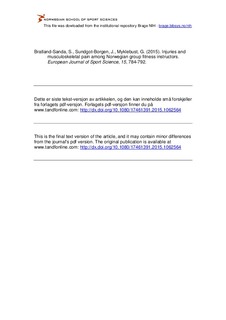| dc.contributor.author | Bratland-Sanda, Solfrid | |
| dc.contributor.author | Sundgot-Borgen, Jorunn | |
| dc.contributor.author | Myklebust, Grethe | |
| dc.date.accessioned | 2017-04-18T11:26:53Z | |
| dc.date.available | 2017-04-18T11:26:53Z | |
| dc.date.issued | 2015-08-09 | |
| dc.identifier.citation | European Journal of Sport Science. 2015, 15, 784-792 | nb_NO |
| dc.identifier.uri | http://hdl.handle.net/11250/2437589 | |
| dc.description | I Brage finner du siste tekst-versjon av artikkelen, og den kan inneholde ubetydelige forskjeller fra forlagets pdf-versjon. Forlagets pdf-versjon finner du påwww.tandfonline.com / In Brage you'll find the final text version of the article, and it may contain insignificant differences from the journal's pdf version. The definitive version is available at www.tandfonline.com | nb_NO |
| dc.description.abstract | Objective: To examine the prevalence and factors associated with instruction-related injuries and musculoskeletal pain among group fitness instructors. Design: Descriptive epidemiology study. Settings: Online survey. Participants: Group fitness instructors from three fitness centre companies in Norway (n = 1473). Assessment of independent variables: questions regarding duration of working as a group fitness instructor, weekly instruction and exercise loading and modality, instruction-related injuries, musculoskeletal pain, use of alcohol, tobacco, snuff, menstrual dysfunction and disordered eating (Eating Disorder Inventory, EDI). The respondents were divided into high instruction loading (HIL), ≥5 h/w with instruction; and low instruction loading (LIL), <5 h/w with instruction). Results: The response rate was 57% (n = 837). Mean total loading (instruction and exercise) was 11.8 h/w and 6.3 h/w in the HIL and LIL groups (p < .001), respectively. The prevalence of acute (9% vs. 6%, p < .05), overuse (38% vs. 24%, p < .001) and both acute and overuse injuries (25% vs. 10%, p < .001) was higher in the HIL than in the LIL group (OR: 3.9, CI: 2.7, 5.5). The most prevalent injury locations were ankle and lower leg. The most frequent location for musculoskeletal pain was the shoulder/neck region. Factors associated with injury were instruction loading (h/w), years working as an instructor and EDI score. A high total EDI score predicted musculoskeletal pain. Conclusion: The high prevalence of injuries and musculoskeletal pain suggests a need for prevention strategies in the fitness industry. There is a need for limits regarding weekly instruction loading, especially for classes with high metabolic and/or mechanical loading. | nb_NO |
| dc.language.iso | eng | nb_NO |
| dc.publisher | Taylor & Francis | nb_NO |
| dc.subject | muscle injuries | nb_NO |
| dc.subject | general sports trauma | nb_NO |
| dc.subject | nutrition | nb_NO |
| dc.subject | disordered eating | nb_NO |
| dc.subject | fitness | nb_NO |
| dc.title | Injuries and musculoskeletal pain among Norwegian group fitness instructors | nb_NO |
| dc.type | Journal article | nb_NO |
| dc.type | Peer reviewed | nb_NO |
| dc.subject.nsi | VDP::Samfunnsvitenskap: 200::Samfunnsvitenskapelige idrettsfag: 330::Andre idrettsfag: 339 | nb_NO |
| dc.source.journal | European Journal of Sport Science | nb_NO |
| dc.identifier.doi | 10.1080/17461391.2015.1062564 | |
| dc.description.localcode | Seksjon for idrettsmedisinske fag / Department of Sports Medicine | nb_NO |
